Cool-down techniques for tennis
Cooling down lowers the heart rate as well as reducing muscle soreness and tightness, removing waste products from muscles and preventing blood pooling.
Melbourne, Australia, 4 July 2013 | Nathan and Giselle Martin | Australian Tennis Magazine
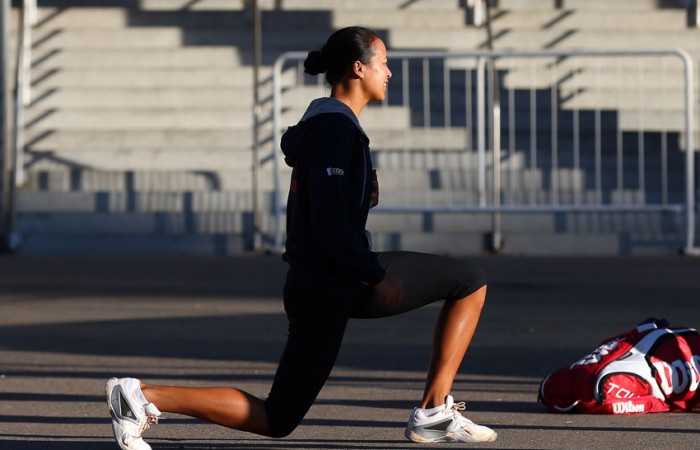
Why cool down?
Cooling down lowers the heart rate and brings the body back to homeostasis, reduces muscle soreness and tightness, removes waste products from working muscles and helps prevent blood pooling.
This cool down should take between 20 and 40 minutes, depending on the intensity and duration of your training or match.
1) Cardio – Jog, bike or swim for 10-20 minutes
2) Stretching – this has many benefits such as:
After exercise, muscles can shorten and feel restricted. Start to be aware of your body, know which muscles feel tight and what side of the body feels tighter. You may have to perform extra stretches on your dominant side. Then only stretch those tight muscles. If we don’t become aware of our body we tend to weaken our kinetic chain as we stretch already lengthened muscles.
Here are some examples of stretches you can perform after a match or training. These will help aid in your recovery for the following day.
Lying on your back, bring leg across the other and rotate the lower body bringing the crossed over knee towards the floor and hold into the stretch. Keep both shoulder blades in contact with the floor. Hold for 30-45 seconds, and repeat on the other side.
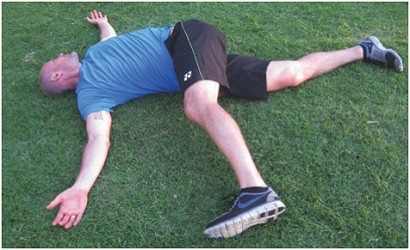
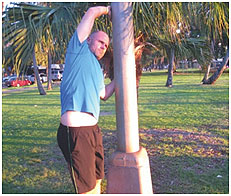 Start in a standing position, placing both feet together. Raise both arms fully extended above the head. Clasp the hands if flexibility will allow.
Start in a standing position, placing both feet together. Raise both arms fully extended above the head. Clasp the hands if flexibility will allow.
Side bend to one side, being careful not to allow any twisting (transverse) movement to occur in the hips or spine. Hold this position for 30-45 seconds each side.
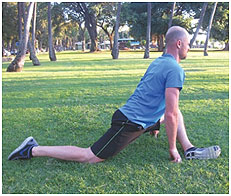 Begin in a runner’s lunge position with both hands on the floor on both sides of the front foot. Keep the right leg straight; the shin of the left leg should be facing forward. Gently allow the hips to come to the floor without allowing any twisting (transverse) movement in the hips. Keep the torso as erect as possible. Hold this position for 30-45 seconds each side.
Begin in a runner’s lunge position with both hands on the floor on both sides of the front foot. Keep the right leg straight; the shin of the left leg should be facing forward. Gently allow the hips to come to the floor without allowing any twisting (transverse) movement in the hips. Keep the torso as erect as possible. Hold this position for 30-45 seconds each side.
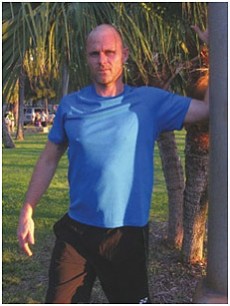 Chest
ChestStand against an object and form a 90-degree angle with your arms as depicted. Slowly rotate your trunk forward around stationary arm until a slight stretch is felt in the anterior (front) shoulder region. Hold for 30-45 seconds each side.
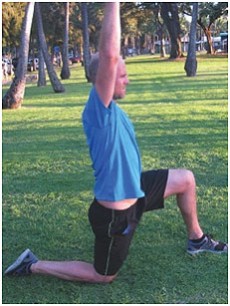 Hip flexor
Hip flexorBegin with one leg in a kneeling position and the other leg bent at a 90-degree angle. Draw the belly button inward. Tighten the gluteals and perform a posterior pelvic tilt (tucking bottom under). Avoid arching the lower back. Hold for 30-45 seconds, repeat for 2-3 repetitions each side.
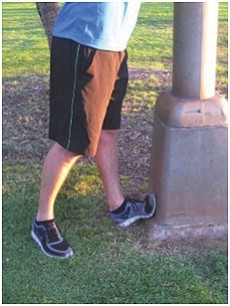 Calf
CalfStand in a staggered-stance near a step. Bring one leg forward for support; use your upper body to lean against wall. Keep foot pointed straight ahead. Stop movement when slight tension is felt and hold for 30-45 seconds, repeat for 2-3 repetitions each side.
Trainers Nathan and Giselle Martin of Energise Health Management have been in the health and fitness industry for 15 years. They travelled on the WTA Tour from 2000 to 2004 and also worked at the Sanchez Casal Tennis Academy in Barcelona, Spain. They’ve worked with Sam Stosur, Svetlana Kuznetsova, Jennifer Capriati, Arantxa Sanchez-Vicario, Monica Seles and Martina Navratilova. The Bondi-based pair now work with Casey Dellacqua and Lleyton Hewitt. For further information, visit www.tennisfitness.com.au.
For more tips from the pros on how to improve your game, check out the latest edition of Australian Tennis Magazine.